Common Pests & Problems
The Most Common Pests and Problems Encountered by Napa County Home Gardener
The UC IPM Statewide Integrated Pest Management Program has produced publications about specific pests or pest management topics that are directed at California's home and landscape audiences. These publications are peer-reviewed and based on UC IPM recommendations.
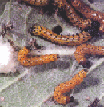
Caterpillars
|
Caterpillars Use row covers, hand pick, spray with insecticidal soap or with the microbial insecticide, Bacillus thuringeniensis. Some parasites for certain species of caterpillars are commercially available. Cultivation kills cutworm larvae hiding in the soil near seedlings. |
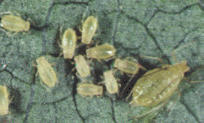
Aphids
|
Aphids Use floating row covers to protect young seedlings. Ignore low populations of aphids. Wash aphids off plants with a blast of plain water. Spray dense populations with insecticidal soap spray or rub between fingers. Be patient and let natural predators control them. Local natural enemies include lacewings, soldier beetles, lady beetles, earwigs and small parasitic wasps. |
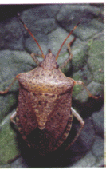
Stinkbug
|
Stink Bugs, Plant Bugs Check plants weekly and remove bugs by hand. Clean up old debris where bugs hide in winter. Use horticultural oil sprays on trees. Insecticidal soap sprays will control juvenile bugs. |
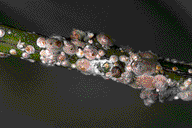
Scale
|
Scale Insects Ignore light infestations. Prune plants to thin out foliage. Local natural enemies attacking scale insects include lacewings, predatory lady beetles, minute pirate bugs, predatory mites, and parasitic wasps. For heavy infestations, use horticultural oil sprays, repeat applications of insecticidal soap, or hand rub branches. Time sprays to control tiny 'crawler' stage.
|

Erawig
|
Earwigs and Sowbugs May feed on seedlings, blossoms, shoots and soft fruits. But, they also help recycle and protect by feeding on dead plant material and soft insects such as aphids. Earwigs avoid sunlight, so keep mulch away from tender plants. Trap in dampened rolled up newspaper. For severe infestations, spray pesticide under hiding places.
|

Snail
|
Snails and Slugs Favored by wet soil surface conditions. Dry garden surfaces - water less frequently and only in the morning. Bright copper flashing or copper screen can be wrapped around tree trunks or planting boxes to repel snails. Control using traps and hand picking.
|
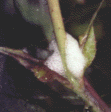
Spittlebug
|
Spittlebugs The froth produced by spittlebugs is unsightly, but these insects seldom harm plants. Ignore spittlebugs on woody plants or wash them off of plants with a forceful stream of water. Spittlebugs are more likely to become abundant when they migrate from nearby weeds. Mow or remove nearby weeds by mid March. |
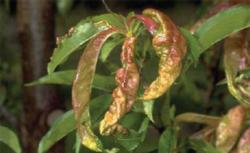
Peach Leaf Curl
|
Peach Leaf Curl Fungus infection of new growth occurs in the winter. Use copper preventive sprays in November and February. Pull distorted leaves in spring. Disease is halted by dry, warm weather.
|
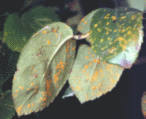
Rust
|
Rust Mildew - Fruits and Berries Mildew - Vegetables Rose Diseases These fungus diseases are specific to plant species. They are spread by wind, rain and splash from sprinklers. Select disease resistant plant varieties. Discourage leaf diseases by keeping plant leaves dry - avoid overhead watering. Remove and compost infected leaves. Preventive fungicide sprays protect new growth only |
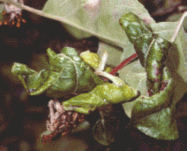
Leaf Curl on Apples and Plums
|
Leaf Curl on Apple and Plum Aphid infestations cause apple and plum leaf curl. Control ants by using sticky band around the tree trunk. Without ants, aphids will be controlled naturally by local predators. Also see Aphids listing above. |
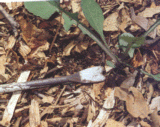
Weeds
|
Weeds in Garden and Landscapes Use frequent cultivation or hand pull. Use mulches or landscape fabrics to shade clean soil and prevent weed seed growth. New seeds may blow-in.
|
